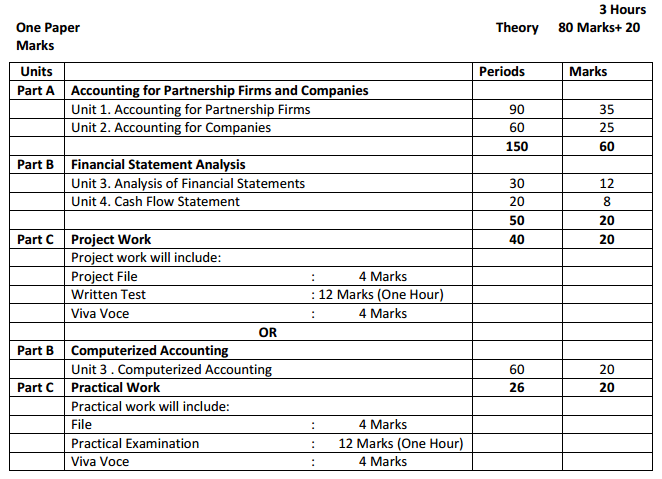(Download) CBSE Class-12 Sample Paper (Accountancy) 2015
Disclaimer: This website is NOT associated with CBSE, for official website of CBSE visit - www.cbse.gov.in

(Download) CBSE Class-12 Sample Paper (Accountancy) 2015

Part A : Accounting for Partnership Firms and Companies 60 Marks 150 Periods
Unit 1: Accounting for Partnership Firms
-
Partnership: features, Partnership deed.
-
Provisions of the Indian Partnership Act 1932 in the absence of partnership deed.
-
Fixed v/s fluctuating capital accounts. Preparation of Profit & Loss Appropriation account- division of Profit among partners, guarantee of profits.
-
Past adjustments (relating to interest on capital, interest on drawing, salary and profit sharing ratio).
-
Goodwill: nature, factors affecting and methods of valuation - average profit, super profit and capitalization.
Scope : Interest on partner’s loan is to be treated as a charge against profits.
Accounting for Partnership firms - Reconstitution and Dissolution.
-
Change in the Profit Sharing Ratio among the existing partners - sacrificing ratio, gaining ratio. Accounting for revaluation of assets and re-assessment of liabilities and treatment of reserves and Accumulated profits.
-
Admission of a partner - effect of admission of a partner on change in the profit sharing ratio, treatment of goodwill (as per AS 26), treatment for revaluation of assets and re - assessment of liabilities, treatment of reserves and accumulated profits, adjustment of capital accounts and preparation of balance sheet.
-
Retirement and death of a partner: Effect of retirement /death of a partner on change in profit sharing Ratio, treatment of goodwill (as per AS 26), treatment for revaluation of assets and re - assessment of Liabilities, adjustment of accumulated profits and reserves, adjustment of capital accounts and preparation of balance sheet. Preparation of loan account of the retiring partner.
– Calculation of deceased partner's share of profit till the date of death. Preparation of deceased Partner’s capital account, executor's account and preparation of balance sheet. -
Dissolution of a partnership firm: types of dissolution of a firm. Settlement of accounts - preparation of
Realization account, and other related accounts: Capital accounts of partners and Cash/Bank A/c (Excluding piecemeal distribution, sale to a company and insolvency of partner(s)).
Note:
(i) If value of asset is not given, its realized value should be taken as nil.
(ii) In case, the realization expenses are borne by a partner, clear indication
should be given regarding the payment thereof.
Unit 2: Accounting for Companies
Accounting for Share Capital
-
Share and share capital: nature and types.
-
Accounting for share capital: issue and allotment of equity shares, private placement of shares, Public subscription of shares - over subscription and under subscription of shares; Issue at par and at premium and at discount, calls in advance and arrears (excluding interest), issue of shares for consideration other than cash.
-
Accounting treatment of forfeiture and re-issue of shares.
-
Disclosure of share capital in company's Balance Sheet.
Accounting for Debentures
-
Debentures: Issue of debentures at par, at a premium and at a discount. Issue of debentures for consideration other than cash; Issue of debentures with terms of redemption; debentures as collateral security-concept, interest on debentures.
-
Redemption of debentures: Lump sum, draw of lots and purchase in the open market (excluding and cum- interest). Creation of Debenture Redemption Reserve.
Part B: (i) Financial Statement Analysis 20 Marks 50 Periods
Unit 3: Analysis of Financial Statements
-
Financial statements of a company: Statement of Profit and Loss and Balance Sheet in the prescribed form with major headings and sub headings (as per Schedule VI to the Companies Act,
1956).
Scope : Exceptional Items, Extraordinary Items and Profit (loss) from Discontinued Operations are excluded.
-
Financial Statement Analysis: Objectives and limitations.
-
Tools for Financial Statement Analysis: Comparative statements, common size statements, cash flow Analysis, ratio analysis. 4
-
Accounting Ratios: Objectives, classification and computation.